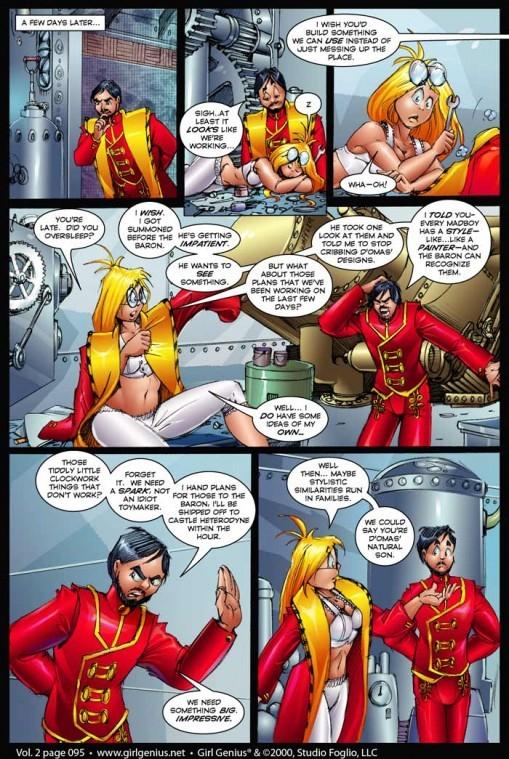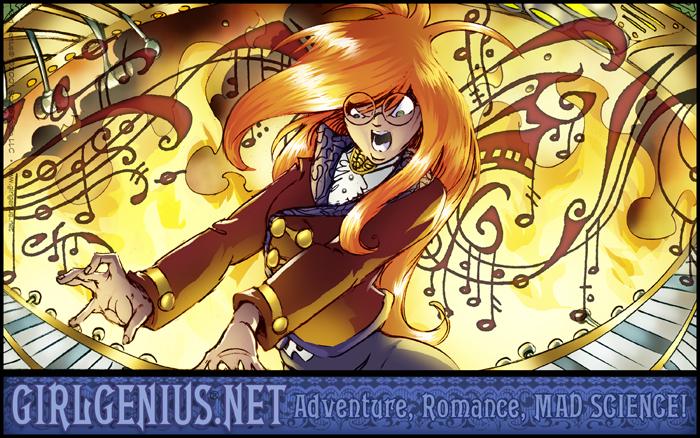The very first time I ever saw artwork by Phil Foglio (pronounced “foe-lee-oh”), he had a regular feature in Dragon Magazine called “What’s New? With Phil and Dixie.” It was hilarious. I followed his work ever since, from “Buck Godot: Zap Gun For Hire” to a stint writing DC’s “Plastic Man” to “Magic: The Gathering” cards and finally to the excellent adults-only comic book “XXXenophile.”
In the early 1990s Foglio married Kaja, an excellent artist in her own right, and they have lived and worked together ever since. Almost a decade ago, in 2002, they launched a comic book titled “Girl Genius,” which has become their longest running work to date. It has classic Foglio artwork, mad science, zeppelins, fantastic monsters, political scheming, excellent humor, steam punk sensibility and tight plotting. As always, I was hooked.
Initially a black and white comic distributed through comic book stores, it moved to color, and then jumped to the web where it has received much wider circulation. Winner of three consecutive Hugo Awards, the comic is even livelier now than when it started. Foglio spoke with The Mass Media from their secret hideout in Washington, with Kaja nearby.
What was the inspiration for Girl Genius?
We wanted to do something with mad scientists, and I enjoyed drawing girls.
I expect there’s a lot of back and forth between you and Kaja. How do you divide the creative work?
We wrote out the actual story arc back in the ‘90s. The rest is choreography. First we talk out what should happen on the next few pages. Then I lay these out in rough form. Then we talk about it until we’re happy. Then I draw the page — yes, on paper, with a pencil. Then it gets scanned… a copy goes to our colorist Cheyenne and another copy goes to Kaja, who does the initial writing pass. We both look at that until we’re happy, then Kaja puts in the word balloons and sound effects. When the color art arrives, she slaps it all together and posts it online. Kaja does all the computer stuff.
What was your first artistic collaborative effort with Kaja?
The first time we worked together was on the “Mishra’s Factory” series of Magic cards.
Typically, web comics make the transition from web-only to printed versions, but yours is one of the few that started out printed and transitioned to the web as the primary mode of distribution. What prompted you to make the change? More importantly, has it worked out well?
We were the first to make that particular transition. The reasons were [partly] financial, and [also] a realization that doing so would make our lives [and] jobs a whole heck of a lot easier. As it turned out, giving our stuff away for free was the best financial move we ever made. Within a year, our readership went from around 9,000 people to over 100,000, and our sales, both on our online store and through comic shops, tripled.
Phil, you’ve had other projects in the past that had plenty of stories left in them. Do you ever want to go back to any of them? Which ones would you most like to revisit?
I have more stories set in the Buck Godot universe that I’d like to do. […] The stuff I did for DC was okay, but I don’t own those characters, and now that I’ve worked for a big company, I know I don’t want to do it again. Ever.
Many of your drawings have lots of tiny little humorous details. When did you first start putting in those little touches, and what made you do it?
I’ve always tried to put that kind of stuff in. I was inspired by the early Mad Magazine artists like Bill Elder, who lived to put weird stuff in the backgrounds.
You won the Hugo Award for best graphic story three years running for Girl Genius. You pulled yourself from the running for the next year. Why?
At the moment the Best Graphic Story category is temporary. At [this year’s] Worldcon, Chicon 7, they’ll vote [on] whether or not it should be made a permanent category. We’ve been part of the science-fiction community so long that people just think of us first, [but] there’s a lot of other good stuff out there. We wanted to let other creators win so that people will see that [it’s] a viable category… not just an excuse to give us Hugos. Not that there’s anything wrong with that.
OK, Agatha Heterodyne: great Heterodyne, or the greatest Heterodyne?
Ultimately? The greatest.
Girl Genius can be read online at http://www.girlgeniusonline.com/, including complete archives. Most of their other work can be found at http://www.airshipentertainment.com/info/comics.php4/.






















































